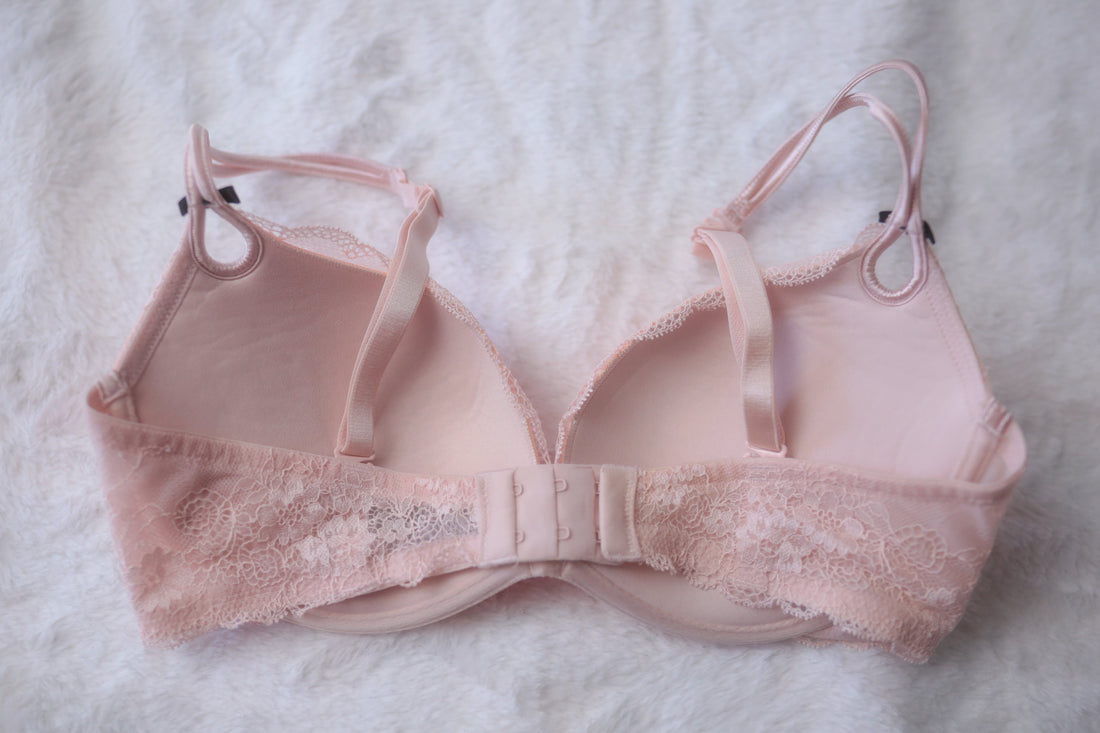
The Ultimate Guide to Bra Construction Materials
This is Part Two of discussing what materials go into a bra so you can better understand what you're wearing. You can find Part One here, which focuses more on the raw materials.
Bras are highly complex pieces that have distinct segments; combining those together into a single unit while allowing each component to fulfill its role requires creativity and the widest-possible range of available material and technology. Understanding can help shed a lot of light in pinpointing the issues you may be having with yours and inform where exactly to make a change.
For those with allergies or particularly sensitive skin, this also reveals the fact that not every material is listed on the label. Tracking down what is causing a reaction isn't just about reading the product tag.
Bra Padding Materials
Bra cup padding materials vary widely depending on the desired effect, such as adding volume, smoothing the silhouette, or providing a natural look.
Foam (Polyurethane "PU" Foam): One of the most widely used materials for bra cup padding, foam is lightweight, flexible, and durable. It’s typically made from polyurethane, a synthetic polymer, which can be molded into various thicknesses and densities. Variations include memory foam, which adapts to the body’s contours for added comfort, and perforated foam, which improves breathability.
Fiberfill (Polyester): Fiberfill is a soft, fluffy, breathable material made from polyester fibers, often used in lightly padded or unlined bras. It’s commonly found in bras designed for subtle enhancement or a natural look, as it adds volume without rigidity.
Silicone: Silicone padding, typically in the form of gel inserts or molded cups, is used in push-up bras or breast enhancers. It’s heavier than foam or fiberfill but provides a realistic feel and weight, closely resembling natural tissue. Often encased in a thin plastic film, silicone is durable and retains its shape well. It’s less breathable, so it’s typically used sparingly in specific areas like the lower cup for lift.
Cotton: Cotton padding, usually in quilted or layered form, is a natural, hypoallergenic option found in comfort-focused or nursing bras. It’s soft, breathable, and absorbent, making it ideal for sensitive skin or post-partum use. While it doesn’t offer significant shaping or lift, it provides light cushioning and a natural silhouette.
Air or Water Pockets: Some bras feature innovative padding with air or water-filled chambers. These are less common but provide adjustable volume and a lightweight feel. These materials are less durable than foam or silicone and may require careful maintenance to avoid leaks or deflation.
Spacer Fabric: A newer development, spacer fabric is a three-dimensional knit material made from polyester or a blend of synthetic fibers. It’s lightweight, breathable, and provides subtle padding without adding bulk. Often used in T-shirt bras, spacer fabric molds to the body while allowing air circulation, offering a balance of comfort and support.
Bra Strap Materials
The materials used for bra straps vary depending on the intended function, durability, and aesthetic appeal.
Elastic (Spandex/Elastane): Most bra straps incorporate elastic materials like spandex or elastane blended with other fibers. These synthetic materials provide stretch and flexibility, maintaining tension to support the bra cups. Elastic straps typically range from 20-30% spandex, with the remainder composed of other fibers like nylon or polyester for strength and durability.
Nylon: A popular choice due to its strength, lightweight nature, and resistance to wear. It’s also dye-friendly, enabling a wide range of color options.
Polyester: Another synthetic fiber frequently used in bra straps, valued for its durability and resistance to moisture and fading. Polyester straps are common in everyday bras because they hold up well to washing and daily wear.
Cotton: For a softer, more breathable option, some bra straps include cotton or cotton blends. While cotton lacks the stretch of synthetic fibers, it’s often paired with elastic to provide comfort, especially in bras designed for sensitive skin or casual wear.
Silk: In luxury or lingerie-style bras, silk may be used for straps to enhance aesthetics and comfort. Silk straps are smooth and lightweight but less durable and stretchy than synthetic options, so they’re typically reinforced with elastic cores or reserved for decorative purposes rather than heavy-duty support.
Foam or Padding: Some bra straps, particularly in sports bras or those designed for larger busts, include foam padding or cushioned layers. This padding is usually encased in a fabric like polyester or nylon to reduce shoulder strain and improve comfort during extended wear.
Bra Adjuster Materials
Bra strap adjusters are small, functional components used to modify the length and fit of bra straps. These adjusters are typically made from a variety of materials chosen for their durability, strength, and compatibility with skin contact.
Hypoallergenic materials like stainless steel or uncoated plastics are preferred for those with metal allergies.
Metal is one of the most widely used materials for bra strap adjusters due to its strength and longevity. Metal adjusters are often coated with enamel, plastic, or electroplated finishes to match the bra’s aesthetic and prevent skin irritation.
Stainless Steel: Resistant to rust and corrosion, stainless steel is a popular choice for high-quality adjusters. It’s hypoallergenic, making it suitable for sensitive skin.
Brass: Often coated with nickel or other finishes, brass provides a sturdy base material. However, nickel-plated brass can cause allergic reactions in some individuals.
Alloy Metals: Zinc or aluminum alloys are lightweight and cost-effective, frequently used in mass-produced bras. These are typically coated to enhance durability and appearance.
Plastic adjusters are lightweight, affordable, and versatile. These are typically molded into shape and can be dyed to match the bra strap color. While less durable than metal, they are less likely to cause allergic reactions.
Nylon: A strong, flexible polymer that resists wear and tear. Nylon adjusters are often used in sportswear or everyday bras due to their durability and smooth texture.
Polypropylene: Another lightweight plastic, polypropylene is resistant to moisture and chemicals, making it suitable for swimwear or activewear bras.
Acetal: Known for its rigidity and resistance to stretching, acetal is used in adjusters requiring precise functionality.
Bra Hooks and Eyes (Closure) Materials
The hooks are typically made from metal, such as stainless steel or brass, due to their strength and resistance to corrosion.
Stainless steel: Particularly favored for its hypoallergenic properties and ability to resist rust, making it ideal for garments worn close to the skin.
Brass: Often coated with nickel or a nickel-free plating, is another popular choice because of its durability and slight flexibility, though nickel coatings can cause allergic reactions in some individuals. To address this, manufacturers may use nickel-free alternatives or plastic hooks for sensitive skin.
Plastic: Usually made from nylon or polycarbonate, are lightweight and corrosion-resistant but less durable than metal, often reserved for lighter-duty garments.
The "eye" component is typically a fabric tape or strip, often made from cotton, polyester, or a cotton-polyester blend. The loops themselves can be metal (matching the hooks) or stitched fabric.
Metal eyes: Usually coated and are sewn into the fabric.
Fabric eyes: Formed by reinforced stitching, these are softer and more flexible but may wear out faster with frequent use.
Bra Underwire Materials
Metal bra underwires are a key component in many bras, providing structure, support, and shape to the garment. Metal underwires are typically shaped into a semi-circle or U-shape, with flattened tips to avoid digging into the wearer’s skin.
Steel: The most widely used material for bra underwires is steel, often in the form of high-carbon steel or stainless steel.
High-carbon steel is prized for its strength and rigidity, allowing it to hold its shape while supporting the bust.
Stainless steel offers the added benefit of corrosion resistance, making it ideal for longevity and comfort, especially in humid conditions or during washing.
Nickel-Titanium Alloys (Nitinol): Some premium underwires are made from nickel-titanium alloys, commonly known as Nitinol. This material is a shape-memory alloy, meaning it can return to its original shape even after being bent or twisted. Nitinol underwires are lightweight, highly flexible, and resistant to deformation, offering a more comfortable fit for all-day wear. However, they are less common due to higher production costs.
Coatings and Finishes: Regardless of the base metal, underwires are almost always coated to improve safety and wearability. Common coatings include nylon, polyester, or epoxy paint. These finishes not only prevent the metal from poking through the fabric or irritating the skin but also allow manufacturers to color-coordinate underwires with the bra’s design.
While metal remains the standard due to its reliability, some modern bras use plastic or resin alternatives for flexibility and hypoallergenic properties, though these lack the same level of structural support.
Plastic: One of the most widely used non-metal alternatives, plastic underwires are made from durable, flexible polymers such as polyethylene or polypropylene. These materials offer sufficient rigidity to support the bust while being lightweight and resistant to corrosion. Plastic underwires can be molded into various shapes and thicknesses, allowing for customization based on bra design and size. They are also hypoallergenic, making them suitable for individuals with metal sensitivities.
Resin: Resin-based underwires, often made from epoxy or polyester resins, are another popular choice. These materials can be reinforced with fibers (e.g., fiberglass) to enhance strength and durability. Resin underwires are known for their smooth finish and ability to maintain shape under pressure, providing consistent support. They are also less prone to cracking or breaking compared to some plastics, though they may be slightly less flexible.
Silicone: Silicone underwires are softer and more flexible than plastic or resin options, offering a comfortable alternative that conforms closely to the body. Made from medical-grade or high-quality silicone, they are highly durable, resistant to deformation, and hypoallergenic. Silicone’s elasticity makes it ideal for bras designed for all-day wear or for individuals seeking a less structured feel, though it may provide slightly less lift than rigid materials.
Composite Materials: Some non-metal underwires are made from advanced composites, combining materials like carbon fiber or nylon with polymers. These composites are engineered to balance flexibility and strength, offering a lightweight yet sturdy option. They are less common due to higher production costs but are valued in high-end or specialty bras for their performance and longevity.
Thermoplastic Elastomers (TPE): TPEs are a hybrid of plastic and rubber, providing a soft, stretchable underwire that retains its shape after repeated use. They are highly adaptable, comfortable against the skin, and resistant to wear from washing or sweat. TPE underwires are often used in sports bras or casual wear due to their flexibility and resilience.
Comment below with any materials you've come to rely on and love or completely avoid. Thanks for reading and nerding out with us about bras!
